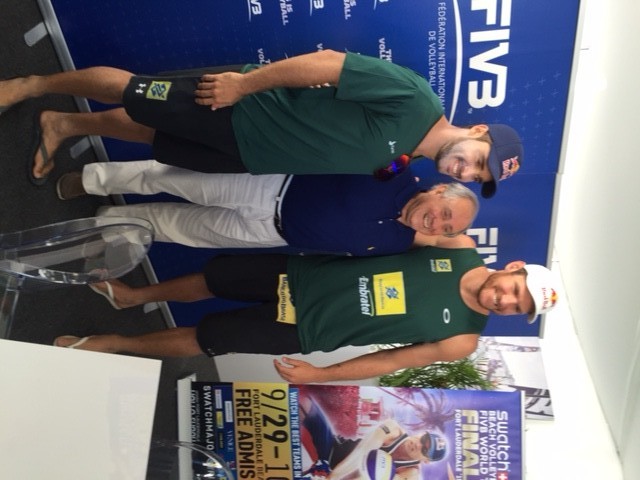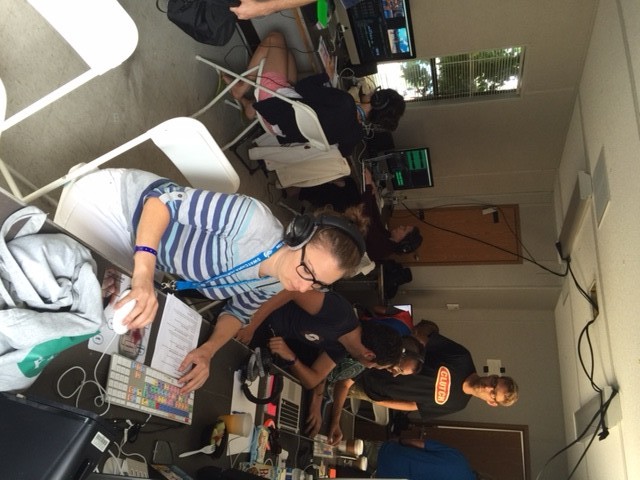FORT LAUDERDALE, Fla. — The International Olympic Committee has had great success at its Winter Games in recognizing that change can be a good thing. Recent years have seen the addition to the Winter program of, among others, snowboarding and slopestyle. Coming next: Big Air. When it comes to the Summer Games — not so much.
That’s why the recently announced additions to the Tokyo 2020 Games of sports such as skateboarding, surfing and climbing -- assuming technical and political problems can be smoothed over -- make for welcome, and long overdue, additions.
In recent years, the IOC, in a bid to reach out to the teens and 20-somethings it avowedly is so interested in reaching, has added BMX cycling to the program. And, before that, beach volleyball.
Nothing — repeat, nothing — highlights the way forward like beach volleyball.
It is, to quote the president of the FIVB, volleyball’s international governing body, Brazil’s Dr. Ary S. Graça, centered on two essentials -- technology and innovation.
Beach volleyball is, altogether and all at once, sport, music, show, scene, party, cultural touchstone.
In those regards -- just like, well, skate, surf and climb.
To play beach volleyball, the women wear bikinis, visors and sunglasses; the guys tank tops, board shorts, baseball caps and shades. In the stands, here at this week’s Swatch 2015 Tour finals, the picture was much the same — bikinis, board shorts, headgear, shades.
Just outside: stands for lemonade. But also margaritas and cold beers.
And a photo booth.
And a contraption, like the one set up at the NFL Combine, where you can see how high you might jump.
As for jumping: before Sunday's men's gold-medal match, between Americans Nick Lucena and Phil Dalhausser and Brazilians Alison Cerutti and Bruno Oscar Schmidt, a gaggle of skydivers from the Red Bull Air Force dropped in, parachuting in from a plane flying out over the nearby Atlantic Ocean.
Standard fare for the NFL, maybe. But Olympic sports? When was the last time you saw a parachute drop to open a modern pentathlon event?
Beach volleyball is not just easy on the eyes. It’s easy — even if you’re new to the sport — to understand.
Scoring is straightforward and common-sense. First team to 21 wins the set; you have to win a set by two points. Two sets wins the match. If there’s a tie after two sets of 21, first one to 15 (again, by two) is the winner.
The average match lasts about 45 minutes, maybe 100 rallies.
Sunday's women's gold-medal event -- Brazil's Talita Antunes and Larissa Franca defeated Laura Ludwig and Kira Walkenhorst, 21-17, 21-18 -- took 39 minutes.
The guys got it done in 38 minutes, Brazil's Alison and Bruno -- as they are known in beach volley circles -- defeating the Americans Lucena and Dalhausser, 21-13, 21-15.
Between every single point, a (loud) rock or hip-hop snippet blasts the speakers — the audio version of a video Vine.
The announcers are amped up, over-the-top, always on, all the time. “If you’re dancing,” one shouted to the crowd amid Saturday’s semifinals, the cameras will find you,” meaning time on the big screens at either end of the court. What do you know? The camera found two young women, one in a blue bikini top, the other wearing yellow.
The announcer cooed: “Hello, ladies!”
At some point, “T-Shirt Steve” is bound to show up and fires free shirts into the crowd.
Cheerleaders come out routinely and shake their groove thing.
Sunny the mascot also did a lot of dancing. And crowd-surfing.
All of this got the crowd so pumped-up for the second of Saturday’s two men’s semifinals — won by Americans Nick Lucena and Phil Dalhausser, both with Florida roots, over a Dutch team — that, afterward, Lucena hopped the restraining wall and high-fived everyone in sight.
“It was probably the ‘funnest’ match I’ve played in, ever,” Dalhausser said.
Lucena called the atmosphere the “most-electric” of any U.S. match he has ever played.
Holland's Robert Meeuwsen, along with Alexander Brouwer the Dutch team that fell to the Americans in Saturday's semis: "The tournament was great. We hope there are more like this. The crowd was really great."
Coming soon: LED nets. If that’s not clear, LED nets mean this: the nets will light up with messages.
On Sunday, Graça made public a nine-point strategic plan that centers on positioning volleyball as “the No. 1 family entertainment sport in the world.”
Note the "family" part.
And that it's not just “sport.”
Nor just “entertainment.
Again, “the No. 1 family entertainment sport” anywhere, with an emphasis on the sport’s reach and popularity among teen girls.
Graça: “The public is going [to matches] to have fun. Not only to see the sport. But to have fun.”
He made a fascinating point — that any number of sports feature what he most deliberately called “violence.”
In combat sports, the violence is real.
But take soccer. Outright assault-style violence? Maybe not often (except in the stands). But rough tackling? Aggressive defensive marking? For sure.
Volleyball, especially the beach version? High-fives and hugs after virtually every point.
“We are giving a new option to the public,” Graça said. “You can choose. If you like violence, OK, you go to a sport where there is a lot of contact and violence. If you don’t, you have a lot of options, and that is volleyball.”
It is the case that volleyball’s plan bears more than a passing resemblance to the nine “smart goals” that USA Track & FIeld chief executive Max Siegel, one of the few executives in the Olympic world ahead of the power curve, set forth at the 2012 annual meeting, his first in charge.
That said, volleyball is looking at unprecedented opportunity. Just ahead: the double bang of Rio 2016, where the sport is not only going to be the big ticket but multiple Brazilian medalists are a distinct possibility, and Tokyo 2020, where volleyball is also big.
It only makes sense to outline a framework like the one Graça did Sunday.
Objectives include becoming a top-tier Olympic sport, along with track and field, swimming and gymnastics; reaching 2 million users on FIVB digital platforms by next year (it made 1 million last month); signing four new global sponsors by 2020; and growing the federation’s annual income, now $31 million, to $66 million by 2020.
How to do this will take “working,” as Graça said repeatedly Sunday. It also will, as he observed several times, take this other factor:
“TV, TV, TV.”
One:
The stadium here holds maybe 3,500. Even if that’s 3,500 whipped-up believers and converts, how does that translate to national or global reach?
Two:
Beach volleyball may already be video and digital miles ahead of almost everyone else in the Olympic movement in one regard — relying on Red Bull’s world-class production expertise, it now cuts and makes available, for free, match (and more) video.
For instance: it’s understood it might well be too expensive now for a German TV crew to travel to Florida for a tourney that runs to multiple days. But when a German team does something noteworthy, like Ludwig and Walkenhorst in making it all the way to Sunday's finals before losing, the mechanism is now in place to call TV outlets in Munich, Berlin, Bonn, Hamburg, wherever, and say, would you like 30 seconds or two minutes on the silver medalists?
Who wouldn’t?
Same idea for certain digital platforms
Click on Red Bull’s Snapchat story Sunday — there, among other stuff, is the Fort Lauderdale event.
It’s not clear who else in the Olympic scene is using Snapchat.
Or, for that matter, if many Olympic federation or national Olympic committee executives even know what it is.
Be assured, however, that young people by the millions know -- and use -- Snapchat.
Graça, again: “We need TV. Without TV, we are going nowhere. But also we have now this social media that is very important.
“I want to talk to 100 million people. And we can do it.”












